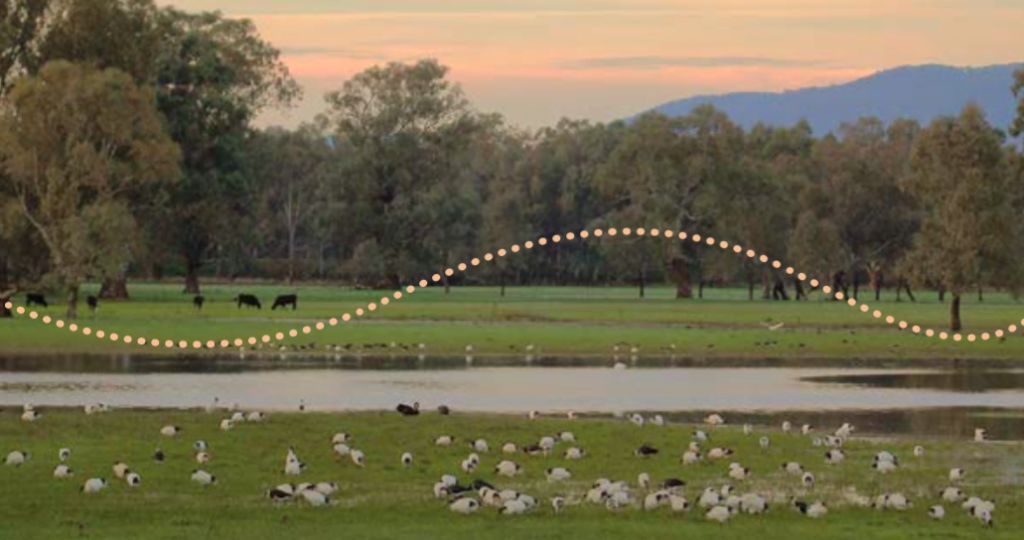Our rivers, wetlands and floodplains have long supported our way of life, providing fresh water, fertile soils and food, as well as spiritual connection and recreation. As we developed the many opportunities created by rivers, it gradually became apparent that our management was having unexpected negative environmental consequences, and that if we were to sustain all of their values, we would need to manage for multiple objectives. This meant we needed to consider how to achieve the delicate balance between the values dependent on the extraction of resources, and the values delivered by a healthy system.
At first, efforts to achieve sustainable management were recognised and initiated at the site scale with local managers, supported by state and Commonwealth governments initiating actions designed to ensure iconic wetland values were protected. The limitations of this approach slowly became apparent, particularly during the Millennium Drought, when it was realised that sites needed to be managed for connectivity and not in isolation. There was also a recognition that flow modification was affecting rivers, wetlands and floodplains across the Murray-Darling Basin, and that Basin-scale management was required to sustain values from individual wetlands to the whole Basin.
The Basin Plan
Our response was to develop the Basin Plan, and the associated purchase of water to protect and restore the Basin’s rivers, wetlands and floodplains. The implementation of the Basin Plan means that there is no an integrated management framework operating at a range of scales from individual wetlands and river valleys, to the Basin as a whole, and from individual flows to long-term flow regimes. This nested management hierarchy is important for two reasons:
- The Plan’s broad environmental, social and economic objectives need to be addressed at a variety of scales, as they are each influenced by drivers and stressors that act at different spatial and temporal scales.
- In order to plan, implement and evaluate management actions at different scales, the engagement of a wide variety of individuals and institutions is required, each playing a role in protecting or restoring the values of the Basin’s aquatic ecosystems.
Learning by doing
The management of aquatic ecosystems is, however, always associated with uncertainty, and the only way to deal with this uncertainty is adaptive management, or ‘learning by doing’. Wherever possible, we need to learn not just from our own experiences, but from the experiences of others. This is vital for a number of reasons:
- It accelerates the sharing and accumulation of knowledge.
- Comparisons of outcomes across sites can provide valuable insights into how systems function.
- There is the potential for large-scale management to influence local management and vice versa.
Collaboration is key
Within this adaptive management context, collaboration across the many different parties involved in the Basin is essential. Without it, there is a risk that projects will work at cross-purposes, limiting or potentially undermining outcomes. Several articles in RipRap 40 demonstrate the productive and collaborative partnerships that are underway between researchers, government agencies and diverse community groups, all working together for the health of the Basin.
Successful collaboration relies on a number of factors – shared vision, clarity of purpose, trust, knowledge and communication.
The Basin Plan and the associated Basin Watering Strategy provide a high level vision for the management of aquatic ecosystems. This provides a frame of reference for people to identify how management of their region or assets can contribute to achievement of the Basin Plan objectives, thereby providing a purpose. RipRap articles contributed by key Commonwealth and state institutions illustrate the roles they play in implementing the Basin Plan, and show how partnerships are critical to their success.
RipRap also has articles about knowledge-generating activities, including research and intervention monitoring. Knowledge is crucial in the planning, design, implementation and evaluation of management actions. The adaptive management approach relies on new knowledge to improve system understanding and implement new practices. We have fascinating articles on Congolli, waterbird flight paths in the Macquarie Marshes and Lower Darling, and Moira Grass in Barmah, all using monitoring to inform management practice. In other instances, research offers a more effective, timely and efficient means of generating new information, as is shared in the Murray-Darling Basin Environmental Water and Knowledge Research stories on waterbirds, vegetation, fish and food webs.
Sharing what we know
Collaboration is also critically dependent on communication which underpins coordination, capacity building, identification of opportunities and the development of new knowledge. We have several stories that show how working with local communities can reap great benefits, whether it be paddling down the Murray, tracking waterbirds or counting seeds. It is the networks that we build between and within institutions and community groups that enable us to motivate and achieve on-ground change, and we have several articles focusing on these human elements of river restoration and management.
We hope that in reading this edition of RipRap you will be inspired to collaborate and continue your efforts to protect and restore the Basin’s fabulous aquatic ecosystems. It is very clear when reading these great stories that the Basin Plan, while large and complex, creates many varied opportunities to influence the condition of our rivers and wetlands. Acknowledging and celebrating the work being done to bring nature, water and community wellbeing together, enables us all to ‘thrive’.
This article was written by Ben Gawne.
You can download this article as a pdf: Thrive: nature, water and wellbeing.
To read this and other great stories like it, you can purchase or download a copy of RipRap 40.


